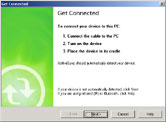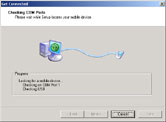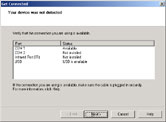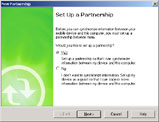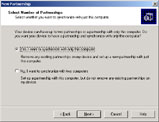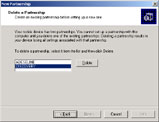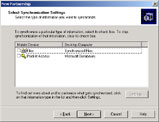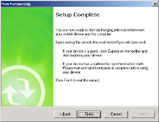Microsoft ActiveSync 4.0Chris Tilley | Editor-in-Chief When it comes down to it, you either love it or hate it. ActiveSync is one of those programs through which your experience will be sound and trouble free, or will be dogged by problems of the type that you loose hair for. If you are the latter, then you probably dread those few seconds that pass each time you cradle your Handheld PC - Locating connection agent - Connecting to Host - Connecting...
The industry has been aware that ActiveSync 4 was on the horizon since before the 3.8 release in January. Windows Mobile devices are underpinned by the Windows CE core operating system version 4.2 and with the transition to CE 5.0 coming in the next few months ActiveSync 4 was always going to be the jewel in the communications crown of the latest generation of devices. With Bill Gate's key note address to the Las Vegas MEDC conference on May 10th, the new Windows Mobile 5.0 (formerly Magneto) is now officially with us, and so is ActiveSync 4. 4200 to 4343When the world first saw evidence that ActiveSync 4.0 was truly on its way, the program was still well and truly in its Beta test stages. Build 4200 was covertly captured and images posted onto the Internet, spontaneously exciting the entire Windows CE Embedded community in a raft of speculation and anticipation, and 128 builds later, the 4th March 2005 '4328' version didn't do anything to quell the Internet's thirst for more information. Another 15 patient builds later and ActiveSync 4 is available for everyone. The first thing you notice is the installer size, at just under 6MB, this is far larger than version 3. Significantly though quite a large proportion of this is down to ActiveSync finally being released in a Windows Installer (MSI) distribution package, rather than the old, clunky InstallShield method. This is mainly significant to corporate administrators who will now be able to roll out and administer ActiveSync from Windows group policy under Active Directory rather than have to go from work station to work station installing the program by hand. As we anticipated, Microsoft has as with many of its applications radically rethought its support policy with ActiveSync 4.0. If you aren't using an NT5 platform (Windows 2000, Windows XP or Windows Server 2003) then with ActiveSync 4.0 you will fall foul of the Microsoft life cycle policy. All compatibility with Windows 95 through Millennium as well as NT 4 has been abandoned. Secondly if you are a user of a supported platform you will also be require to have a base Service Pack level installed on the system. For Windows 2000 that is SP4, with 2003 the requirement is SP1, while XP maintains support for both SP1 and SP2. For most users already running one of the three compatible operating systems this will generally not pose a problem outside of large scale corporate environments. If you are a Itanium 64 or x64 user then ActiveSync 4.0 shouldn't disappoint, with Microsoft looking certain to release optimised builds for both 64-bit platforms around the time of the Windows Mobile 5.0 release. It is because of this that increasingly ActiveSync 4.0 carries with is the air of being more of an adjustment release than something radically different fitting in nicely with the changes going on within Microsoft itself, and in the IT world in general. The installation itself requires around 24MB of disk space and places much emphasis on the updating of USB drivers used to connect most if not all modern Windows CE based devices. To this end though the process is rather time consuming, more so than the dreaded 96% lockup during the ActiveSync 3 installation routine; to add insult to injury if you are performing an upgrade installation you will need to restart your computer at the end of it. Bitter Sweet; the taste of progressInevitably Host system requirements haven't been the only significant change in the support guise of ActiveSync 4.0. In recent years Microsoft have increasingly come to rely on the support road maps laid down in their very visible Support Lifecycles. The company has been enforcing the implementation of the application lifecycle policy with conviction and fervour, wiping their support burden for legacy software from the proverbial slate and allowing them to focus more resources on the here and now, and of course into future product development. Unfortunately the Handheld PC has for nothing more than Political reasons now become a victim of this support policy. The ActiveSync 4.0 team have now changed the base supported platform for any connecting device up from ActiveSync 3's CE 2.00, to CE 3.00. Unlike in ActiveSync 3.5 and higher, where support for these older versions of Windows CE existed in an unsupported capacity - but none the less was present. ActiveSync 4.0 rigidly enforces this change in platform support. 
This change in the device support in ActiveSync 4.0 will come as a bitter disappointment to many in the Handheld PC community. Worryingly this has occurred at an exceptionally inopportune moment for the IT world, as we step into the realm of 64-bit computing and are turning the final corner on the road to Longhorn the cumulative effect of the decision to restrict synchronisation access to anyone not using a Windows CE 3.00 or higher may be that within 24 months legacy device users may not be able to synchronise their devices at all.
If you are fortunate enough to be a HPC2000 or Windows CE 4.x user, then as the devices use CE 3.0 or higher to operate under, your H/PC remains fully supported by ActiveSync 4. If you performed an upgrade install from ActiveSync 3, then things will remain more or less the same, but if you need to perform a fresh install, or are adding a new device then you will start to see some of the evolutionary interface changes that are present in version 4.
Aside from the graphical changes, the wizard itself is predominantly unchanged from the previous release, even down to the connection scan in which support is still maintained for old fashioned serial port connections. The art of CommunicationUSB is now the default connection method, with ActiveSync being denied access to Serial (COM) ports by default (a change carried over from ActiveSync 3.8). Using the get connected wizard will override this while probing ports, preventing a sure fire technical support overload come release day. As with all versions since the 3.1 release, the USB driver subset seems to have been tweaked. With all the emphasis on USB Driver installation during the installation, hopefully this release will spell an end to problematic connection time outs caused when the system, frantically searching for drivers is unable to mount the driver before the device itself drops the connection. 
Version 4 appears to aid Windows in doing this, with the 'grab' time seeming much swifter than before. You will be given the opportunity to find this out for yourself, as ActiveSync provides us all with the opportunity to test this as a full driver reinstall is carried out the first time you connect your device after the installer enforced reboot. With the improvements in the communications system, it is surprising that there has been a rather large omission from ActiveSync 4. 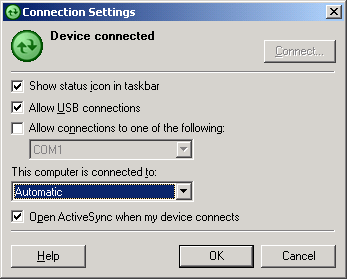
Pay a visit to the new, simplified Connection Settings area and you may not notice it at first. However two options are missing from the screen. At this time understanding the reasons why this change has been made can only be speculation. The most probable reason for this change is due to the inclusion of the "Microsoft Server ActiveSync" technologies into this release for use against Microsoft Mobile Information Server (MIS) in a corporate environment. Worryingly though this is going to cause serious problems for new device users who rely on Wireless networks for synchronisation. Interestingly the support for Remote synchronisation via ActiveSync server has been built into this release, along with support for SQL server synchronisation. To do this ActiveSync makes use of a local server module which can be run from your PC. Speculating, it is possible that when Windows Mobile 5.0 is released things will become clearer. It is possible that Microsoft have chosen to migrate the Remote Synchronisation abilities of the previous versions into this secured web sync system. The connection can be kept secure by the encryption key being passed to the device when the partnership is created for the first time.
InterfaceAside from the changes to the Connection Settings, Get Connected and Partnership wizard, you could be excused for thinking that ActiveSync 4.0 lacked any sort of changes to the main interface; and you would almost be right. Connect up a Handheld PC or Pocket PC to it and things look identical. However a chance has it all is not as it seems. Have a device mount ActiveSync without a partnership and you get to see a glimpse of what is in store for the program. 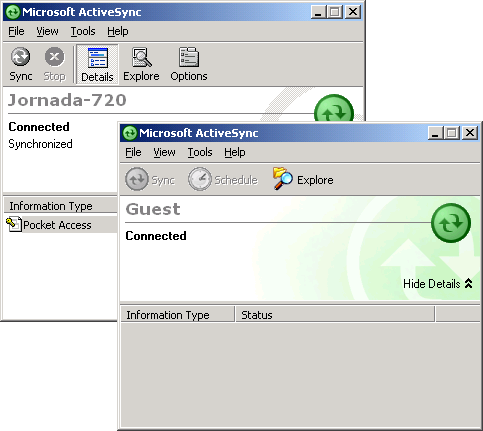
The adjusted graphics and icons are complemented with a simplified toolbar, on which Schedule now sits centre stage. 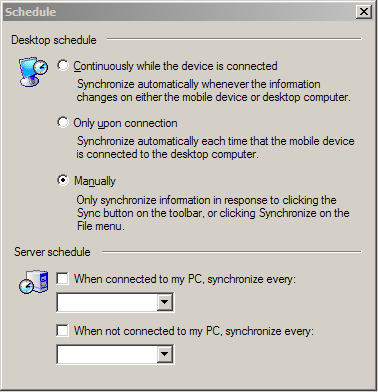 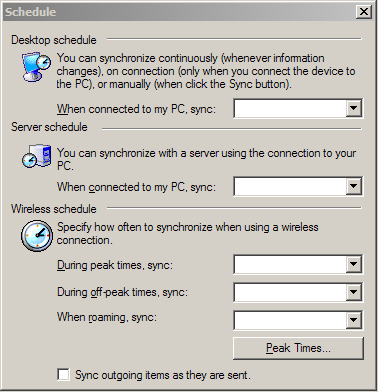
In the corporate environment this allows for the idea of peak and off-peak times to be worked into ActiveSync's setup, providing administrators with the flexibility to maximise the bandwidth they have at their disposal. The settings also allow you to control the scheduler based on your own personal routine, when you are cradled, or roaming the building for example. Or even when Outlook e-mail volume is higher than average. Other than the updated graphics present in the connection wizards we assume that all other cosmetic changes are reserved for connections to Windows Mobile 5.0 devices. Even for Windows Mobile 2003 devices, the are no apparent changes. As in previous releases, 4 maintains the backup and restore functionality, as well as the import and export controls for Windows CE database store and fundamentally ActiveSync is still the same program version 3.8 was. HPC2000 devices still maintain support for Pocket Access, the PIM functionality still exists and local file transfer through Windows Explorer remains the tried and tested method of moving data back and forth from PC to device. Unfortunately though file copies still lock the sending and receiving windows, meaning you are unable to continue file browsing when moving large files both onto and off of the PDA. Additional features have been added in the guise of a tighter level of Media integration. If you are lucky enough to be a Windows XP user, and have installed Windows Media Player 10 along with it, the ActiveSync installer contains some connection and integration tools (KB894476) which effectively will allow anyone with a compatible device to keep their remote music library synchronised through the use of playlists as part of the ActiveSync synchronisation process. This differs from the system under ActiveSync 3.8, where by you have to shell out to Windows Media Player and initialise a synchronisation. ConclusionOver all it is too easy to fall into the trap of expecting far more from ActiveSync 4.0 that has been delivered. With the modern emphasise on the cosmetic and unashamedly aesthetic parts of computing to have seen the slightly altered user interface made available to everyone would have gone some of the way to making the release feel fit for 2005. In reality Microsoft are caught between a rock and a hard place. The ActiveSync team score points for the MSI redistribution, for the outstanding work they have achieved towards facilitating the corporate 'client - server' synchronisation ideal, and for the new Schedule and Media synchronisation features. Unfortunately though these are meaningless to the Handheld PC community, and will be met with an increasing ambivalence by the emerging community of legacy Pocket PC users. Over all, ActiveSync 4.0 feels more like "ActiveSync 3.9" when you consider the entire package, and playing games with user support while at a time when we now urgently need fully supported 64-bit software version is going to alienate an increasing number of users away from the platform, and away from the one thing you really are going to need to make version 4 shine - Windows Mobile 5.0 . It is for these reasons that we are forced to advise users within the Handheld PC community not to install ActiveSync 4.0 unless you categorically will not require remote access support within your setup. System RequirementsHPC2000, Windows CE 3.0, 4.x .net, 5.0, Pocket PC 2000, 2002, Windows Mobile 2003, 2003SE, 5.0 More information on Microsoft ActiveSync 4.0 can be found at Ratings
Further DiscussionLet us know what you thought of this review and the Microsoft ActiveSync 4.0 in the Community Forums! | |||||||||||||||||||||||||||||||||||||

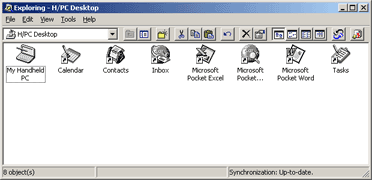 ActiveSync was a vast improvement over it's predecessors. H/PC Explorer and Windows CE Services were over thought, painfully unreliable and featured as a distinct turn off from Windows CE when compared to the smooth, seamless synchronisation that many saw as offered by the competition.
ActiveSync was a vast improvement over it's predecessors. H/PC Explorer and Windows CE Services were over thought, painfully unreliable and featured as a distinct turn off from Windows CE when compared to the smooth, seamless synchronisation that many saw as offered by the competition.